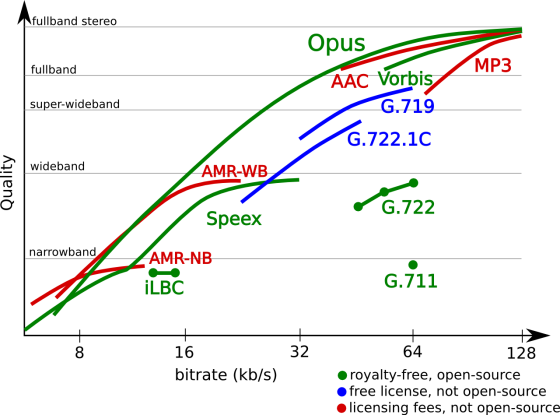Opus Audio Codec

Opus is a multipurpose audio codec that combines the balance of high-quality audio signal compression with low delay rates. It was developed in 2012 by the IETF working group. Its flexibility lies in adapting to changes in channel’s bandwidth capacity and support of any kind of audio encoding. Nowadays, Opus audio codec is considered to be the best in all respects among its rivals, because its quality is even superior to the widely used MP3.
All existing codecs can be relatively divided into two groups: general-purpose codecs with long delays, but high quality (Vorbis, AAC and MP3) and codecs for speech encoding with small delays, but low quality (Speex, G.719, G.722.1, G.722.2, G.729, iLBC, AMR-NB). None of these codecs is capable of maintenance of the highest audio encoding quality and keeping delay at a minimal level at the same time.
However, Opus audio codec can be considered a successful exception, as it is suitable for reproducing a signal at 6 kbit/s, as well as at 510 kbit/s. Signal compression is performed with minimal losses, almost imperceptible to the human ear. Opus audio codec can dynamically switch to compression with different bitrate depending on changes in bandwidth capacity.

Features and Benefits:
- Supports any sample rate from 8 to 48 kHz.
- Bit-rates from 6 to 510 Kbps.
- Support for mono and stereo.
- Support for both constant bit-rate (CBR) and variable bit-rate (VBR).
- Using a fixed-point arithmetic.
- 5 ms delay.
- Easily scalable audio stream with the ability to change settings dynamically.
Opus Audio Codec in TrueConf Video Conferencing Products
As a result of numerous studies and tests, Opus audio codec was recognized as the most suitable codec for speech compression. That is why our company has implemented it in all our solutions. Good audio quality in video conferencing is just as important as the quality of the video.
Resulting from comparison with other popular speech codecs, used in video conferencing: Speex and G.729, Opus scored the highest productivity and the ability to quickly switch between various encryption mechanisms. This made it ideal for use in video conferencing during data transfer. Video conference participants can continue to communicate with each other in the most comfortable audio environment even at a low-speed Internet connection.


Follow us on social networks